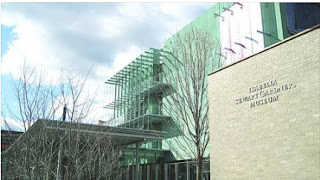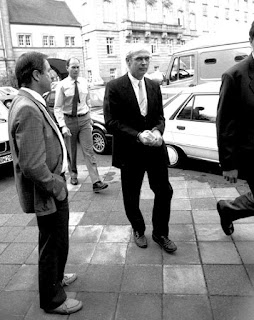The Gardner Heist Investigation In The Media (Part VI)
The year 2014 was slow, nearly dormant in terms of news coverage of the Gardner Heist. It began with an unsigned January 19th editorial in which the Boston Globe counseled patience for a Gardner art recovery.
The Baltimore Museum’s "flea
market Renoir" was making its way back home from where it had gone missing sixty
three years earlier, in 1951. Paysage
Bords de Seine had just been ordered returned to the museum by a judge
earlier in the month.
The editorial stated: “Last year, the FBI announced it had reached a breakthrough in its
search for the missing Gardner paintings. That hasn't led to their discovery
yet, but successful recoveries like the one in Baltimore show why there's still
grounds for optimism.”
The editorial could have served as an opportunity for the FBI, in a letter to the editor, or in a request to be
interviewed, or something, to restate their confidence, their commitment, their progress, their brand of optimism for a recovery of
the Gardner Museum art that would not take another four decades. But nothing was heard from
Gardner Heist investigators then on that or any topic until two months later.
What passed for an anniversary
news story that year came late. It was a report that the lead investigator in
the Gardner robbery, FBI Special Agent Geoff Kelly had told the local Fox News affiliate that
there had been confirmed sighting of the paintings. "We
believe that over certain periods of time, this artwork has been spotted," Kelly told the
station. "There have been sightings of it, confirmed sightings," he said.
The Associated Press picked up
the story and that version was published in the Boston Globe. But Kelly was
only repeating what he had said three months earlier in an interview
for WGBH in December of 2013. The story
was hardly a scoop, It was at that
point, old news.
“We have had confirmed sightings of some of these pieces
throughout the 90s and into the early 2000s and that really gives us a comfort
level that these paintings had not been destroyed,” Kelly
said during that interview in December of 2013.
The 2014 “confirmed sightings”
announcement was met with skepticism by at least one close Gardner Heist
follower, Attorney Nicholas O'Donnell, author of A
Tragic Fate: Law and Ethics in the Battle Over Nazi-Looted Art
O'Donnell pointed out in his blog, The Art Law Report, that what Agent Kelly was saying was not really all that different than what had been said a full
year earlier around the time of the anniversary of the heist, by the head of the FBI’s Boston office, at the time, Richard DeLauriers.
Another skeptic was the retired FBI agent Robert Wittman, who founded the FBI's art crime team and played a lead role in an undercover operation to get some of the Gardner Heist paintings back. Wittman spent the bulk of his career working out of the FBI's Philadelphia office and less than two weeks after the FBI's big press conference on March 18, 2013, Wittman said:
“I sat next to the organized crime squad guys,” Wittman said in a telephone interview from his suburban Philadelphia office this week. “If they had heard anything, I would have known about it. We didn’t hear a thing.”
Were these confirmed sightings real? A brother of one suspect had said on America’s Most Wanted in 2009 that he had seen Manet's Chez
Tortoni hanging in George Reissfelde's Quincy, MA bedroom three months after the robbery. But It had
taken him nearly two decades to come forward.
Stephen Kurkjian said in
a radio interview on August 4, 2015, and
perhaps earlier, that “I was told by the FBI lead agent in
the case in 2010 [Special Agent Geoff Kelly] that they had yet to have a
confirmed proof of life sighting of any of the 13 pieces.” He reiterated this statement in a radio interview on WNPR in Connecticut in September of 2017.
The AP story did have some additional information, however. It reported: “The latest, exhaustive phase in the inquiry is based on a tip that a
caller made to authorities in 2010, according to Anthony Amore, the Gardner
Museum’s head of security and chief investigator. "He said in 2013 that the tip was so fruitful — leading to the announcement that investigators know the identities of the thieves.” the Globe reported.
So the tip did not lead to the identification
of the thieves, but it did lead to the announcement that their identities were known. This may seem like hair splitting but no one before or since has ever said the identity of the thieves is based on a caller's tip in 2010. There is a similar mote of obfuscation surrounding any and all discussion related to the identity of the thieves by investigators whose statements on the matter are never in quotation marks.
In 2010
Elene
Guarente, claimed she observed her husband Robert Guarente, an organized crime figure, open the trunk of their car and hand over two or
three paintings to Robert Gentile, a small time Connecticut mobster, whom she believed were the stolen Gardner Museum
paintings.
However, a subsequent article in the New York Times would
suggest that this tip, referenced in the 2014 article, was one originating in Philadelphia. It was separate from the Elene
Guarente lead. Special agent Kelly later said in 2015 that a witness deemed credible by the FBI claims to have seen one of the paintings, “The Storm on the Sea of Galilee,” Rembrandt’s only seascape, when someone tried to sell it in Philadelphia around 2003.
And Gentile was known to have crime associates in Philadelphia, so these two tips, would reinforce each other. But only If Gentile were involved, which appears less and less likely to be the case.
And Gentile was known to have crime associates in Philadelphia, so these two tips, would reinforce each other. But only If Gentile were involved, which appears less and less likely to be the case.
And that was it for 2014.
What looked like an effort to reignite the Gardner Heist crowd sourcing campaign, in December of 2013, at the end of the Whitey Bulger drama, with his sentencing to life in prison, turned into an ongoing investigation with no media coverage to speak of from that point for nearly a full year.
The next big story was not until February of 2015. It was a
Gardner Museum story but not exactly a Gardner robbery investigation story.
Five weeks before the 25th anniversary and ten months before she
actually left her position, Anne Hawley announced she was stepping down as head
of the museum.
In speaking with Malcolm Gay of the Globe, announcing she was stepping down as Director, Hawley did not discuss the investigation or the
attempt to recover the paintings, but only the sense of loss and violation she
felt over the robbery “That was shattering,” Hawley said. “We don’t
often look evil in the eye, but that part of the human condition is what we’ve
worked with for almost 25 years.”
“Look evil in the eye”? “Worked with for almost 25 years”?
For Hawley, even twenty five years later, the Gardner Museum
robbery was something that was very much a crime still in progress.
The Fox News story the previous year announcing
“confirmed sightings” had described the Gardner Museum robber as “like something
out of a Hollywood thriller,” but what happened afterward had nothing of the
glamour of Hollywood. Anonymous threats against the museum, "several" staff members, and against
the director Hawley herself and her family, were simple, brutally direct and terrifying.
But “I was not going to be defeated by that,” she said. “It galvanized
people to conserve the collection. We had to transcend that horror.”






